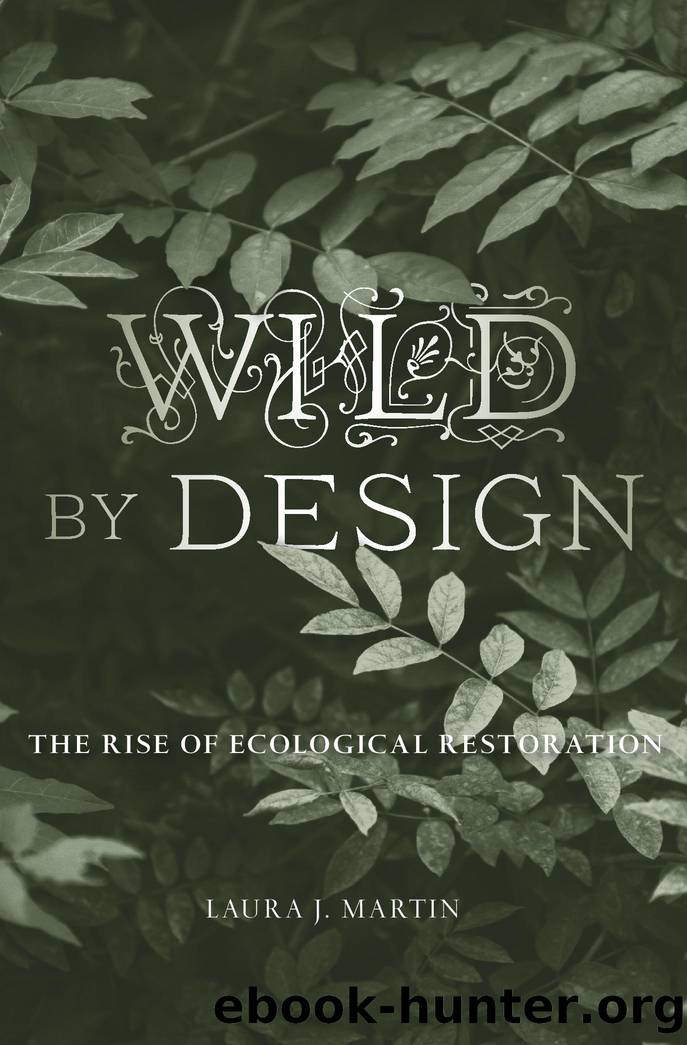Wild by Design: The Rise of Ecological Restoration by Laura J. Martin

Author:Laura J. Martin [Martin, Laura J.]
Language: eng
Format: epub
Tags: History, United States, 20th Century, nature, ecology, Environmental Conservation & Protection, Political Science, Public Policy, Environmental Policy, Science, Life Sciences, environmental science
ISBN: 9780674979420
Google: 5ipfEAAAQBAJ
Amazon: 0674979427
Publisher: HarvardUP
Published: 2022-05-17T00:00:00+00:00
Ecologists promoting the precolonial baseline thus depended either on naturalizing Native Americansâdiminishing their agency by considering them âpart of natureâ like nonhuman animalsâor on trivializing their established impact on the land. Ecologists and land managers routinely suggested that Native Americans, unlike white settlers, were part of âwildâ or âprimevalâ nature. Jenkins wrote that âthe Indian was a resident rather than manager or destroyer of the wilderness.â59 Reed Noss held open âthe question of whether Indians should be considered a natural and beneficial component of their ecosystems, perhaps coadapted with fire and the vegetation since the Pleistocene.â60 A 2003 article in the journal Ecological Restoration acknowledged that many national parks âwere shaped by the unremitting labor of generations of indigenous peoples.â But rather than calling for restoration of Indigenous sovereignty, it suggested that ecologists should âsimulate the actions of indigenous peoplesâ in areas âno longer used by tribal peoplesâ in order to restore biodiversity to a precolonial state. The article alternately described Native American actions in definitely agential terms (âmanagement regimesâ) and in arguably naturalizing terms (âindigenous disturbancesâ), and suggested that ecologists could learn about, and then âmimicâ or âsimulate,â Native American harvest and fire practices.61
Few ecologists in the 1980s, then, debated the politics of the goal of restoring ecosystems to a precolonial baseline.62 But they did debate the feasibility of achieving that goal. When NPS scientists and their academic collaborators attempted to establish a precolonial baseline, they envisioned past plant (and, much more rarely, animal) communities using both historical documents (settler diaries, land surveys, photographs) and paleoecological studies of fossil pollen, tree rings, and charcoal deposits.63 This created a role for paleoecologists in species management.64 Colonial records of species were rare and notoriously unreliable, however, and paleoecological data was biased toward those species whose pollen was best preserved. Uncertainty about the composition of precolonial ecological communities proved an impediment to restoration. For instance, following the Leopold Report, the National Park Service set January 1778 as their restoration baseline in HawaiÊ»i, permitting species introduced by ancestors of native Hawaiians but excluding âthose that are post-Cook.â But one University of HawaiÊ»i ecologist argued that, even after removing nonnative plants and animals and reintroducing native ones, it would not be possible to restore ecosystems in national parks to late-eighteenth-century stages, âsimply because we donât know what these were.â65 There were significant practical impediments, too, including conflicts over how to restore precolonial plant species while minimizing intervention. Between 1971 and 1975, the NPS killed 12,976 introduced goats in Volcanoes National Park in HawaiÊ»i. But efforts to eradicate goats from Volcanoes National Park would pit scientists against one another. While many ecologists believed that goats preferentially ate native plants like the endemic koa tree, others believed that goats could be a useful tool in controlling the spread of nonnative plant species.66 Threats like species introductions and climate change were also practical impediments to minimalist restoration, and remain so, because they are diffuse and ongoing. Today, many ecologists ask whether it is possible, or wise, to
Download
This site does not store any files on its server. We only index and link to content provided by other sites. Please contact the content providers to delete copyright contents if any and email us, we'll remove relevant links or contents immediately.
| Anatomy | Animals |
| Bacteriology | Biochemistry |
| Bioelectricity | Bioinformatics |
| Biology | Biophysics |
| Biotechnology | Botany |
| Ecology | Genetics |
| Paleontology | Plants |
| Taxonomic Classification | Zoology |
Sapiens: A Brief History of Humankind by Yuval Noah Harari(14312)
The Tidewater Tales by John Barth(12625)
Mastermind: How to Think Like Sherlock Holmes by Maria Konnikova(7276)
Do No Harm Stories of Life, Death and Brain Surgery by Henry Marsh(6905)
The Thirst by Nesbo Jo(6877)
Why We Sleep: Unlocking the Power of Sleep and Dreams by Matthew Walker(6651)
Life 3.0: Being Human in the Age of Artificial Intelligence by Tegmark Max(5506)
Sapiens by Yuval Noah Harari(5321)
The Longevity Diet by Valter Longo(5039)
The Body: A Guide for Occupants by Bill Bryson(5027)
The Rules Do Not Apply by Ariel Levy(4907)
The Immortal Life of Henrietta Lacks by Rebecca Skloot(4548)
Animal Frequency by Melissa Alvarez(4424)
Why We Sleep by Matthew Walker(4394)
The Hacking of the American Mind by Robert H. Lustig(4336)
Yoga Anatomy by Kaminoff Leslie(4331)
All Creatures Great and Small by James Herriot(4267)
Double Down (Diary of a Wimpy Kid Book 11) by Jeff Kinney(4240)
Embedded Programming with Modern C++ Cookbook by Igor Viarheichyk(4138)
